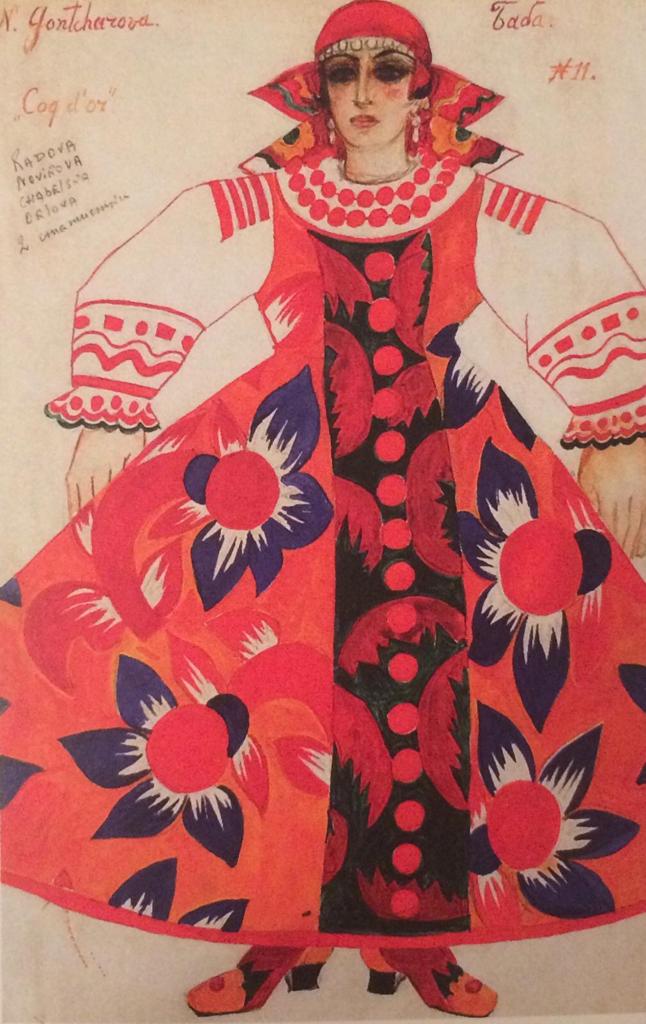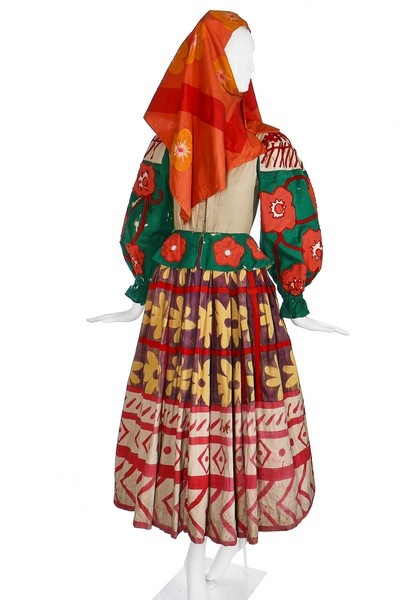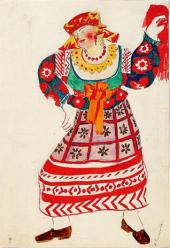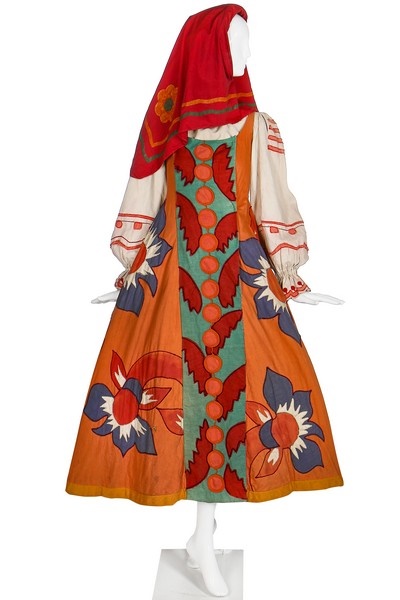

28/04/2020
Those of you who saw the Tate Modern’s retrospective of Natalia Goncharova’s work last year will be excited to learn that we have four lots designed by the avant-garde Russian artist in our 8th December Passion for Fashion sale.


Left: lot 53, Diaghilev's Ballets Russes 'Le Coq d'Or' costume for a female subject of King Dodon, estimate £4,000-6,000
Right: the costume as illustrated by Goncharova
These four lots are four costumes designed by Goncharova for the opera-ballet Le Coq d’Or, first staged by the Ballets Russes in 1914. Each costume showcases Goncharova’s love of bright colours and vivid floral designs, while harking back to traditional Russian dress. Intended to be worn by female ballet dancers, the ensembles are comprised of orange and green pinafores and skirts, worn over a blouse in linen or cotton, richly embroidered and appliquéd with scarlet and plum braid. Each ensemble features a kokoshnik, a traditional Russian headdress, cheerfully stencilled with yellow daisies. These costumes were worn by dancers portraying the female subjects of Tsar Dodon, around whom the action turns.
Rimsky-Korsakov’s opera, his final work before his death in 1908, was in fact based on an 1834 poem by Alexander Pushkin, who was Goncharova’s great-uncle.[1] Le Coq d’Or was the first of several ballets which Goncharova worked on for the Ballets Russes, bringing her unique futurist sensibilities, familiarity with European expressionism and sense of humour. It is said that Goncharova’s work often serves as a sort of bridge between Russian and European art and this can be seen in her costume design.[2] Not only did she design the costumes but also the scenery, creating a fully fleshed-out fantasy world for the viewer. This all-encompassing artistic vision was key to Goncharova’s work: beyond producing paintings and drawings, she was notorious for being her own canvas, experimenting with painting symbols and patterns on her own body.
Goncharova was a flamboyant character who had made a name for herself as a proponent of futurist art through her involvement with pioneering artistic movements such as Der Blaue Reiter and Donkey’s Tail. She and her partner Mikhail Larionov also founded Rayonism, a form of art which relied on abstract, sharp lines to convey rays of light. They wanted to encapsulate the extreme dynamism of the 20th century and their work featured a clash of colours.


Left: 'Peasant Woman' by Natalia Goncharova, 1937
Right: lot 52, Diaghilev's Ballets Russes 'Le Coq d'Or' costume for a female subject of King Dodon, estimate £5,000-8,000
It was upon moving to Paris in 1914 that Goncharova began designing costumes and scenery for the Ballets Russes. The collaboration between these two beacons of Russian cultural activity seems quite natural. The contribution of the Company’s impresario and founder Sergei Diaghilev to modern ballet was revolutionary, especially in terms of the design and staging of ballets, thanks to his engagement of artists whose bold vision enlivened his productions. These collaborations were not always successful – as in the case of Goncharova’s partner Larionov’s costumes for Chout, where the costumes were deemed “unwieldy”, hindering the dancers in their movements.[3] Certainly, when you imagine the outfit of a ballerina, you might envisage something light, floaty and feminine. The sketches made by Goncharova in preparation for the creation of the Coq d’Or costumes are the antithesis to this: they portray stocky women in heavy outdoor boots, swathed in layers of colourful, cumbersome fabric. Goncharova’s designs, however, were lauded – so much so, that when Le Coq d’Or was revived in 1937 by the Ballers Russes under the direction of Colonel Wassily de Basil, Goncharova was again called in to design the costumes. She reinterpreted her 1914 designs for this later production, and it would seem she was given a bigger budget, as she was able to make the costume for the eponymous golden cockerel out of real gold thread this time.[4]
The costumes we have up for sale seem to have been made for the 1937 production, based on the labels and names to be found on the inside of the items. Woven labels bearing the name ‘Karinska’ have been stitched into two of the outfits. Karinska (1888-1983) was one of the 20th century’s most famed costume designers.[5] She had first made costumes for the Ballets Russes de Monte Carlo in 1932 and it would seem that she made these too, following Goncharova’s designs. The other names inked into the costumes are likely to be the names of the ballerinas who danced in these costumes, amongst them Anna Lendrum, Sylvia Herklots, Lee Stemmler, Irina Zarova (born Yvonne Leibbrandt) and Natasha Sobinova (born Rosemary Deveson).[6]
 Lot 54, 03/12/2013, cocktail dress by Natalia Goncharova for Myrbor
Lot 54, 03/12/2013, cocktail dress by Natalia Goncharova for Myrbor
Textile designs and embroideries had long constituted a key part of Goncharova’s oeuvre – a natural form of expression for the artist, given her family had made their fortune through textiles.[7] She designed for the Moscow-based couturier Nadezhda Lamanova and later on, for the French fashion house Myrbor. In fact, KTA sold one of her designs for Myrbor back in December 2013, hammer price £12,000: a rare and important futurist appliqued cocktail dress, circa 1924-25, unlabelled, crêpe de chine ground applied with abstract metallic panels, richly-coloured silks and velvets, with triple tiered flounces to one hip.
Recent sales of Goncharova’s paintings have sold for hundreds of thousands – if not millions - of pounds. With estimates ranging from £1,000-1,500 to £5,000-8,000 for each of these four lots, do not miss your chance to invest in a work of art designed by one of the twentieth century’s most original artists.
[1] Rosie Lesso, 'Natalia Goncharova: The Spirit of Russia', accessed April 2020, https://blog.fabrics-store.com/2019/05/30/natalia-goncharova-the-spirit-of-russia/
[2] 'Le coq d'or: Natalia Goncharova's Designs for the Ballets Russes', accessed April 2020, https://www.harvardartmuseums.org/exhibitions/2609/le-coq-dor-natalia-goncharovas-designs-for-the-ballets-russes
[3] Bowlt, John E. “Stage Design and the Ballets Russes.” The Journal of Decorative and Propaganda Arts 5 (1987): 28–45. https://doi.org/10.2307/1503934
[4] 'Le Coq d'or Premiered...', accessed April 2020, http://myballetsrusses.blogspot.com/2011/10/le-coq-dor-premiered-oct-7-1909-in.html
[5] 'Karinska Biography', accessed April 2020, http://www.roh.org.uk/people/karinska
[6] 'The Ballets Russes - a Century Ago', accessed April 2020, https://www.dcd.ca/specialexhibits/balletsrusses.html
[7] 'Exhibition Guide', accessed April 2020, https://www.tate.org.uk/whats-on/tate-modern/exhibition/natalia-goncharova/exhibition-guide